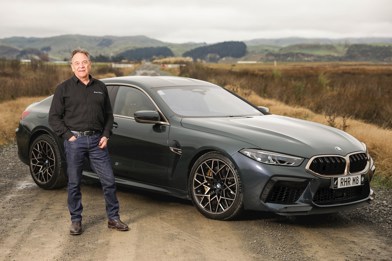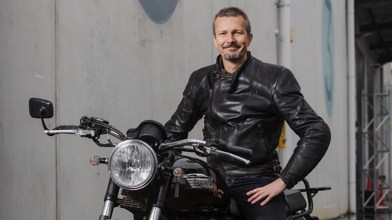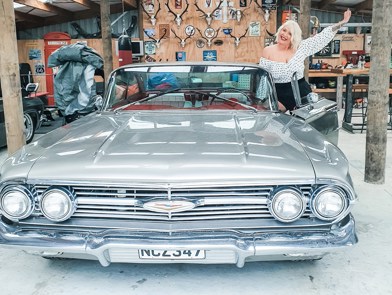Tony Lowe's garage is a cornucopia of delight for almost any classic car-owner. Having trouble with your pre-war car's single windscreen wiper? Here's a box of reconditioned workings from the period. Need a steering box for an equally ancient Austin? Tony happens to have one stacked between a couple of shelves.
Tony's current restoration project is a 1915 Studebaker raceabout, but that's not what we have to write about. It's the rarity out front we're here to see, a 1971 Honda 1300S 9. The little coupe has beautiful lines, a soundtrack that's pure motorsport sin, and an interesting history as Soichiro Honda's last automotive obsession.
Many of the decisions Soichiro made for this car owe much to his engineering, motorcycling and motorsport background. Instead of soldering panels, these were welded, which made the car stiffer. And Soichiro wouldn't hear of a water-cooled engine. That might have been cheaper to build, but it didn't fit with his passionate approach. After all, Soichiro's first car was a sportster with a 500cc four-cylinder engine modified from a bike.
This one would be bigger, and when it was unveiled at the 1968 Tokyo Motor Show it came with a 1.3-litre engine. It produced more power than the 1.6-litre Corona of the time, but Soichiro wasn't happy with its 74kW. So, before the car went on sale in 1969, he had his engineers build a more aggressive motor, still a 1.3, but with four Keihin carbs and 89kW on tap. That wasn't bad for a car tipping the scales at under 900kg.
With air-cooling and a dry sump, it had more in common with supercars and motorcycles than your average shopping hack.
Indeed, peer beneath the bonnet and you'll even spot motorcycle-style cooling fins.
From 1969 to 1973, more than 45,000 1300 sedans and coupes were built, but just 7881 had this engine. The handsome little body you see in these photographs arrived only in 1970. Allegedly, only a few were exported, and - as you can imagine - in the 40 years since, a great many of those have fallen by the wayside, especially as it was obvious that the sporty engine had a possible career in motorsport.
Tony acquired his car in 2007, along with a number of stories which he hesitates to pass on, as he doesn't know which ones are true. He does know it raced in red, and that Honda lost track of it. And that, one day, a Japanese car company bloke turned up looking for "a red one" and knew nothing about "a yellow one".
But open the doors, and you can see the original red in the gap ... However, we digress.
As far as Tony knows, this car resurfaced, after a period in obscurity, at a Turners auction in 2001. However, no one knew what it was. Kevin, a friend of his, bought it.
"He collects cars and bought half a dozen and put them in a shed." A bit later, another friend, Jim, acquired it. Meanwhile, Tony had been doing some research, and was sure he knew what it was.
"I like weird stuff and persuaded Jim to sell it to me. It just needed a bit of maintenance and then it was good to go."
Take this Honda for a short drive, and instantly you long for a closed road, for this engine isn't really happy bumbling along at round-town speeds. At under 3000rpm or so it's lumpy, almost rough, but stick to second gear in town, push past that threshold and the motor smooths out, and really starts hauling until the 7500rpm power peak - or when common sense intrudes.
Better still, the handling is more than up to the job. Honda mounted the engine in a subframe, rather than using the more common unibody. Weight was well distributed, and the front Mac strut and rear suspension set-up is quite stiff, and benefits from long rear swing axles mounting on the opposite chassis rail to cut twist and roll. It means you don't really need to slow for junctions, you can just fling the car around. It's easy to forget it's a front-driver.
I discovered this largely because the brakes are, frankly, crap. Plant that pedal to the floor and little happens. You have to pump it, which means planning ahead - or throwing the car around. No wonder Tony had had a mind to take it racing. "All it needs is a roll bar and a fire extinguisher."
Mind you, you're taking a risk racing it. If something goes wrong, you can't get the parts. Tony is already having some trouble tuning the carbs. As he says, "You really need to know something about motorbikes. This engine is like having two 650cc Honda GP motors in it."
It almost seems a shame he has retired from the track, but the revvy little motor in this pretty coupe is happy to keep his ears in tune to the sound of the wild.




